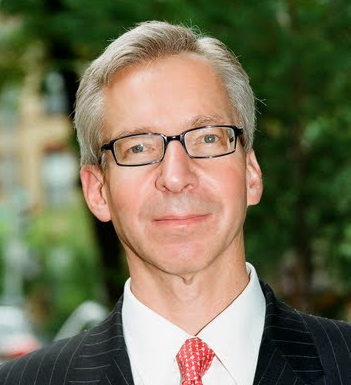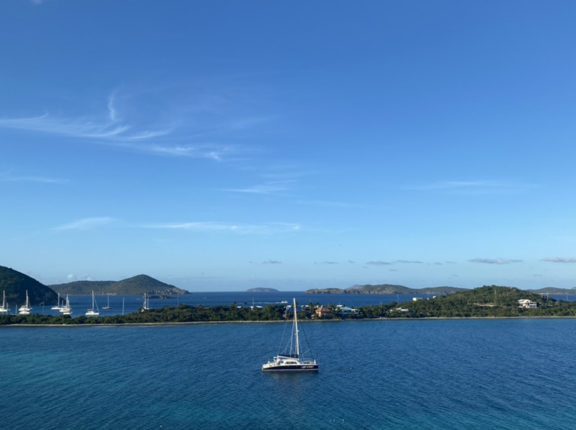Interview with Clinton Bush Haiti Fund CEO Gary Edson
Above: Employees at an atelier in Port-au-Prince (Photo: CBHF)
By Alexander Britell
Soon after the devastating earthquake in Haiti, former US Presidents Bill Clinton and George W Bush, at the behest of President Barack Obama, founded a fund aimed at bringing Haiti out of the crisis, largely through economic growth. More than a year and a half later, the Clinton Bush Haiti Fund has helped lead the charge toward helping Haiti’s economy develop, led by CEO Gary Edson. Edson, a former Deputy National Security Advisor and Deputy Assistant for International Economic Affairs under President Bush, talked to Caribbean Journal about Haiti’s economy, the fund’s work in the epicenter of the quake, Leogane, and growing the country’s economy.
One of the main goals of the fund has been promoting economic growth in the country. How much has Haiti’s economy developed since the earthquake?
What we know is that Haiti is obviously now pivoting, as it should, from a large concerted effort by the global donor community and others who directed post-disaster relief, some of which continues to be ongoing, to longer term reconstruction and that’s great. We can see that taking place at our level. Anecdotally, I will tell you that I think early on we were the outlier. There were folks giving clean water, consumables like food, medicine and nutritional supplements, and people were kind of asking, either explicitly or implicitly, “Gee, what is the Clinton Bush Haiti Fund doing focusing on jobs when people need water and sanitation?” The good news is that I think just as Haiti is pivoting toward these longer-term economic issues, so, too are the rest of those trying to assist the rebuilding effort.
What are you seeing on that end?
I think the good news is there is an increasing recognition that our focus on economic opportunity–promoting jobs, training of the workforce, etc. — has to be a cornerstone of successful reconstruction. I can’t tell you with great precision where Haiti stands economically in terms of the reconstruction. What I can tell you is that what we see are more and more organizations now focusing on the things we’ve been focusing on since the beginning. I remember during the cholera outbreak, a lot of people asked, “Why aren’t you giving more money to cholera?” And my answer to that was that, first of all, there are a lot of bigger and better organizations that are combatting cholera. But that having been said, cholera, as with so many of the issues Haiti faces, are symptoms of a larger disease – poverty. Cholera has its roots in poverty, as do so many of the other problems in Haiti. And what the Clinton Bush Haiti Fund is focused on is addressing that root cause – mainly, fighting poverty.
Above: Gary Edson
One of the Fund’s recent grants was aimed at boosting microfinance in Haiti. How powerful can that be in rebuilding the economy?
It can be tremendously powerful. One of the characteristics of microenterprise is that when things are going well, it expands rapidly, and when things go poorly, it implodes rapidly. After the earthquake, we saw a lot of major microfinance institutions with badly-affected balance sheets. And so early on, we made one of our priorities to shore up the balance sheets of key microfinance institutions in Haiti, and, to date, we’ve spent well over a million-and-a-half dollars supporting three key microfinance institutions which collectively serve over 9,000 microentrepreneurs –85 percent of whom are women. The first step was shoring up their balance sheets, so they could maintain their client base, and of course, once that’s done, expanding it. And we’ve done that, both directly in supporting these institutions, as well as through a facility that we were the catalyst in launching with the Inter-American Development Bank’s Multilateral Investment Fund (MIF) called the Haitian Emergency Liquidity Program, which bought bad loans off of the balance sheets of some of these microfinance institutions, hence injecting new capital into the institutions. So that’s been a key focus of ours, and will continue to be a key focus, not least of which because of its huge impact on women.
If the Haitian economy is going to continue to develop, what will be its greatest drivers of growth?
if you look at the private sector plan that was presented at the [UN] conference in March 2010, it focused on what were expected to be the largest job-generating sectors. And those are obviously the garment/apparel sector, agribusiness, tourism/crafts,and construction, among other things. There is lots of potential within the agricultural sector. Virtually every egg you eat in Haiti is from the Dominican Republic – where none of that was the case decades ago, and none of that should be the case today. But it’s going to take a lot of work to reboot that agriculture sector and upgrade the supply chain. Our loan to Root Capital is largely focused on agribusiness, including coffee production, which we think can be a huge source of jobs and environmental remediation at the same time. The other thing I’m seeing is growth in the garment sector. One of the first things that President Bush and President Clinton did at the very outset of the Fund was to lobby the US Congress for a huge increase in the limits on apparel and garment imports from Haiti, and the limits were virtually quadrupled, which, in turn, created the incentive for the Koreans and others to invest hundreds of millions of dollars in new production in Haiti. We have two assets – we’ve got some capital, and we’ve got the brand value of two presidents, and we leveraged that brand value to get what I think is a huge win for Haiti.
Are there areas in Haiti that have performed particularly well?
We are very supportive of the decentralization of the economy. Again, the microenterprise institutions are all over Haiti. We also have done a lot in the craft sector – not only in Port-au-Prince but also in Jacmel. One city that we have also focused on is Leogane, the epicenter of the quake – which, interestingly enough, seems not to have gotten as much attention as it should. We’ve done many things there from bringing broadband to schools and clinics and businesses, to supporting, together with the Pan American Development Foundation and the Caterpillar Foundation – the rehabbing of some of the “yellow-tagged” homes, that were categorized not as undamaged but also not as unsalvageable, which is a quick way to get people back into their homes. In Leogane, we have also supported YouthBuild’s job training effort. We are part of a very large project, together with the Mastercard Foundation, the IDB’s MIF, YouthBuild and a Haitian partner, IDEJEN, to train over 5,000 at-risk and out-of-school youth in construction work. We committed to building the first two academies that will train these young people, and the first one was constructed in Leogane. One of the things we’ve tried to do is be the first mover – the catalyst in projects, using our brand value, as well as our capital. In this case, they planned 10 academies throughout Haiti, and we said, “Okay, we’ll fund the first two.” So Leogane has become a bit of a center for our activities and obviously has great symbolism.
Has any initiative surprised you by its success?
Well, I think our work in the craft sector has been surprisingly successful. The craft sector is tremendously fragmented, and hence has a hard time producing at the volumes and the quality levels that large US and European retailers want. But by working with some creative organizations, we’ve been able to link those producers, particularly the producer associations in places like Port-au-Prince and Jacmel, with major retailers, ranging from Macy’s to Anthropologie and others, that’s creating orders of significant magnitude in terms of dollar amounts. That’s helped retain jobs, as well as create new jobs as additional orders come in. I think another project that we’ve done that is proving to be remarkably successful is on the training end of professionals. One thing that was clear after the quake was that there really was no good emergency care at all in Port-au-Prince, particularly at the state hospital, HUEH. And we gave a grant of a million-and-a-half dollars to International Medical Corps to create an emergency care training program for doctors and nurses at HUEH, and they are learning skills that they did not have and that are critical in an emergency. There was one doctor who went through this training, and the very week that he completed it, he was presented with a case that, had he not received the training, the patient would have died.
How would you describe the performance of the fund so far?
We’re about promoting lives and livelihoods Our training of nurses and doctors with International Medical Corps has been a quick win and will continue to bear fruit over time. But keep in mind, we’ve only really been operating for about 16 months, and it’s only been 20 months since the quake.. When you’re dealing with job creation, there’s a lot of seeds we’re planting now that will come to fruition later. For example, when it comes to job promotion, we estimate that to date, we’ve sustained or created 11,000 jobs – that includes jobs in small- and medium-sized enterprises, in the agriculture sector, in the garment sector. But we expect those efforts to yield an increasing number of jobs over time. So it’s a little too soon to judge what the ultimate impact of this Fund will be. But thus far, we’re seeing good results in microfinance and in small- and medium-sized enterprises. I think the whole workforce development and training effort will be a huge asset for Haiti. Remember, we’re working to support the Haitian people’s efforts to support their country, so any success that’s realized isn’t ours – it’s theirs. It’s one of the reasons these presidential funds have a relatively short half-life – we’re not meant to be in Haiti forever – we’re meant to get in, be a catalyst, build Haitian capacity and get out. And let the Haitians take charge and ownership of their own rebuilding. It’s about a change in the whole development paradigm of Haiti – from donor and aid-driven development, which tends to generate dependency, and create moral hazard, to private sector-driven development which empowers people and is truly sustainable.








